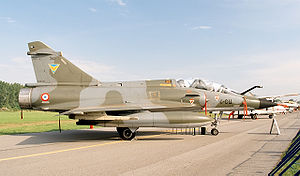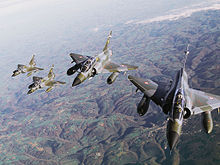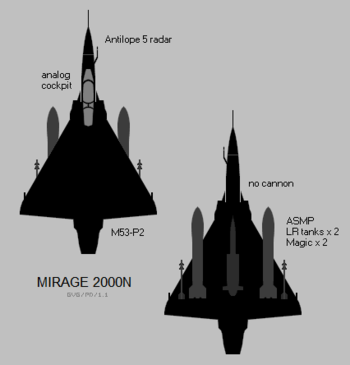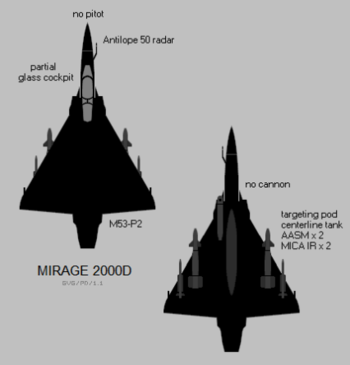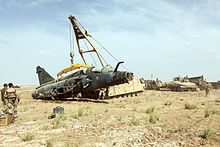- Dassault Mirage 2000N/2000D
-
Mirage 2000N/D Mirage 2000N at the Radom Air Show, Poland Role Fighter-bomber Manufacturer Dassault Aviation First flight 3 February 1986 Number built 75[citation needed] Developed from Mirage 2000 The Dassault Mirage 2000N is a variant of the Mirage 2000 designed for nuclear strike. It forms the core of the French air-based tactical nuclear deterrent. The Mirage 2000D is its conventional attack counterpart.
Contents
Development
The Mirage 2000N was designed to French requirements for an aircraft to replace the older Mirage IVP. Dassault received a contract to build two prototypes. The aircraft first flew on February 3, 1986. Seventy four were built up to 1993.
The Mirage 2000N is based on the Mirage 2000B two-seat trainer, but features considerable changes. The airframe was strengthened for low-level flight and fitted with an Antilope 5 radar, which is used for terrain following, navigation and ground mapping, and which can follow terrain at 691 mph (1,112 km/h). Other avionic features are twin INS's and moving map displays for both the pilot and weapon systems officer. The Mirage 2000N can carry one ASMP medium-range nuclear missile, and can also carry two MATRA Magic AAM's for self defence. Other protection features include the Sabre jamming system and the Spirale chaff system. Because the extra seat decreases range, a pair of drop tanks are carried. Since the Mirage 2000N's standard weapon was the ASMP, which was carried on the centerline pylon, that meant it couldn't carry a centerline tank, but a distinctive big 2,000 liter (530 US gallon) underwing drop tank with a bulbous nose was developed to more than compensate
The first batch of 30 aircraft for the French Air Force had a sole nuclear capability, and these were designated Mirage 2000N-K1. These did not have the Spirale chaff system, and carried a pair of AN.52 free-fall nuclear bombs before the ASMP was ready. The later batch of 44 aircraft were designated Mirage 2000N-K2. These had both a nuclear and conventional capability, and a full defensive fit. The K1 aircraft now have a limited conventional attack capability.
Dassault has also developed the Mirage 2000D, which is a development of the Mirage 2000N designed for long-range precision strikes with conventional weapons. This aircraft is exactly the same as the Mirage 2000N, but introduces support for conventional attack missiles such as the Apache and Scalp missiles, as well as the AASM weapons. The first aircraft, converted from the Mirage 2000N prototype, flew on the 19th February 1991, and the French Air Force ordered a total of 86 aircraft.[1]
The Mirage 2000N is not licensed for export. The French Air Force has 62 in its inventory.
Like the Mirage 2000N, the Mirage 2000D had variants. The Mirage 2000D-R1 does not have the full weapons capability of the Mirage 2000D-R2, which features the Apache and Scalp missiles, the ATLIS II laser designation system, and the Samir self-protection fit.
Variants
Mirage 2000N
The Mirage 2000N is the nuclear strike variant which was intended to carry the Aerospatiale Air-Sol Moyenne Portee (ASMP) nuclear stand-off missile. Initial flight tests of two prototypes began on February 3, 1983, and the Mirage 2000N entered operational service in 1988. A total of 75 were built.
The fighter had strengthened wings for low-altitude operations, as well as low-level precision navigation/attack systems, built around the Dassault/Thales Antilope 5 radar, which was designed for the strike role and featured a terrain-avoidance capability.
The ASMP missile is 5.38 meters long with a kerosene-powered ramjet that allows it to cruise at Mach 3 to a maximum range of 100 km carrying a nuclear warhead with a yield of 300 kT.
Upgrades:
- The existing kit was enhanced to provide an electronic intelligence (ELINT) capability, allowing the aircraft to record data on adversary emitters for post-flight intelligence analysis.
- A SAT Samir "Detecteur de Depart Missile (DDM)" missile-warning system was also added, being attached to the back of the Magic AAM pylons.
- Future upgrades include the addition of a Pod Reco NG (Pod de Reconnaissance Nouvelle Generation) to provide digital reconnaissance capabilities, with both day and night imagers, a digital data recorder system, and a datalink to provide real-time relay of imagery to battlefield commanders. It is being developed by Thales for service introduction in 2006.
Aircraft with the updated countermeasures system and capable of carrying both the ASMP-A missile and the Pod Reco NG will be redesignated "Mirage 2000N-K3".
Mirage 2000D
Delays in the Dassault Rafale fourth-generation fighter program led to a development program for an updated Mirage 2000N dedicated to conventional attack, originally designated Mirage 2000N cousin. It was to complement SEPECAT Jaguar daylight strike fighters by providing a night/bad weather attack capability.
Formal development began in 1988. The designation was changed to Mirage 2000D in 1990, with the "D" standing for "Diversifie/Multirole". Initial flight of the Mirage 2000D prototype, a modified Mirage 2000N prototype, was on 19 February 1991. That led to first flight of a production aircraft 31 March 1993 and introduction to service in April 1995. 86 Mirage 2000Ds were built in all to last delivery in 2001.
The Mirage 2000D featured:
- An NVG-compatible cockpit, with improved "hands on throttle and stick (HOTAS)" controls and a partial "glass cockpit" arrangement. The pilot obtained a second display, and the back-seater received two more for a total of three in the rear.
- A modernized ULISS 52P navigation system with Global Positioning System (GPS) capability,
- An improved Antilope 50 terrain-following system.
- An updated "ICMS 2" countermeasures system, with SERVAL RWR, Chameleon jammer, and Spirale dispensers.
Full-specification Mirage 2000D-R1 aircraft could carry stores such as:
- All major dumb munitions, such as iron bombs, Belouga cluster bombs, Durandal runway breaker bombs, BAP 100 and BAP 120 clusters, Matra 68 millimeter rocket pods, and cannon pods.
- Laser-guided weapons such as the AS-30L ASM or French and US LGBs, with the munitions directed by an ATLIS II or improved optical-infrared PDLCT and high-resolution PDLCTS targeting pods, attached to a pylon under the right air intake. The navigator/WSO in the back seat handled laser targeting while the pilot in the front flew the aircraft. Carriage of the next-generation Damocles pod is now under consideration.
- The Armat antiradar missile, though this is rarely carried.
The Mirage 2000D remains in service, with various improvements such as the MICA IR. A general upgrade designated Mirage 2000D-R2 machine was delivered from 2001. A second upgrade program was begun in 2009, with better support for the strike role and improvement of air-to-air capabilities. This provided a multirole capability that compensated for the eventual retirement of the Mirage 2000Cs.
Operators
- Armée de l'Air
Operational history
Operation Deny Flight and Deliberate Force
French Mirage 2000s were prominent participants in UN and NATO air operations over the former Yugoslavia. On 30 August 1995 one Mirage 2000D was shot down over Bosnia by a MANPADS heat-seeking 9K38 Igla missile fired by air defence units of Army of Republika Srpska during operation Deliberate Force, prompting efforts to obtain improved defensive systems.
Operation Enduring Freedom and ISAF
AdA Mirage 2000Ds served in the intervention in Afghanistan in 2001-2002, operating in close conjunction with international forces and performing precision attacks with LGBs. The French Air Force deployed the Mirage 2000D to Manas Air Base in Kyrgyzstan from 2002 to 2004 to support coalition forces in Afghanistan. Then from 2004 to 2007, they stayed at Dushanbe, Tajikistan. In summer 2007, after the Rafale fighters have been removed from the theater of operations, 3 French Mirage 2000s were deployed to Afghanistan in support of NATO troops. To shorten the response time to support NATO ISAF troops in southern Afghanistan, the aircraft moved to Kandahar International Airport. Three Rafale F2 and three Mirage 2000Ds operate from Kandahar in 2008.[2] On 24 May 2011, a French Air Force Mirage 2000D crashed 100 kilometers west of Farah. Both crew members successfully ejected and were recovered.[3]
Opération Harmattan and Unified Protector
French Air Force Mirage 2000D were committed since the beginning to the enforcement of the Libyan no-fly-zone that was approved by the UN in March 2011. The Mirage 2000Ds were among the first strikers: on 19 March 2011, a mixed French formation of Mirage 2000s and Rafales hit a Libyan army column that was heading for Benghazi with several vehicles destroyed. The Mirage 2000D remained one of the most used striker for the next months when Opération Harmattan was succeeded by the UN led Operation Unified Protector.
Notable accidents and incidents
- On 1 March 2011, one Mirage 2000N crashed in Creuse region of central France near the village of Saint-Oradoux-pres-Crocq during a night flight. Both pilots were killed.[4]
- On 24 May 2011, one Mirage 2000D crashed 100 kilometers west of Farah, Afghanistan. Both crew members successfully ejected and were recovered.[5]
Specifications (Mirage 2000D/N)
General characteristics
- Crew: 2
- Length: 14.55 m (47 ft 9 in)
- Wingspan: 9.13 m (29 ft 11 in)
- Height: 5.15 m (16 ft 11 in)
- Wing area: 41 m² (440 ft²)
- Empty weight: 7,600 kg (17,000 lb)
- Loaded weight: 10,680 kg (23,550 lb)
- Max takeoff weight: 17,000 kg (38,000 lb)
- Powerplant: 1 × SNECMA M53-P2 afterburning turbofan
- Dry thrust: 64 kN (14,300 lbf)
- Thrust with afterburner: 95.1 kN (21,400 lbf)
Performance
- Maximum speed: 2,338 km/h (1,289 kn, 1,453 mph)
- Combat radius: 800 NM (1,480 km, 920 mi)
- Ferry range: 1,800 NM (3,340 km, 2,100 mi)
- Service ceiling: 18,000 m (59,000 ft)
- Rate of climb: 285 m/s (56,000 ft/min)
- Wing loading: 410 kg/m² (85 lb/ft²)
- Thrust/weight: 0.91
Armament
- Hardpoints:
- 4× under-wing
- 4× under fusolage
- 1× centerline
- Rockets:
- Up to 4x Matra SNEB 68-mm 18-round rocket pods on the four underwing hardpoints
- Missiles:
- Air-to-air missiles:
- Up to 4× R550 Magic air-to-air missiles for self-defence, normally 2 on the ouboard underwing pylons
- Up to 4× MICA IR air to air missiles for self-defence, normally 2 on the ouboard underwing pylons
- Air-to-ground missiles: - Mirage 2000N
- Air-to-air missiles:
- Bombs:
- AASM 125, 250, 1000 Kg laser, ISN/GPS, IIR guided bombs. The lighter versions are carried in pairs on the centerline and inboard wing hardpoints and one under each of the four fuselage hardpoints
- up to 10× GBU-12 227 Kg laser guided bombs, in pairs on the centerline and inboard wing hardpoints and one under each of the four fuselage hardpoints
- up to 3× GBU-16 454 Kg laser guided bombs on the centerline and inboard wing hardpoints
- up to 3× GBU-10 907 Kg laser guided bombs on the centerline and inboard wing hardpoints
- up to 3× GBU-24 907 Kg laser guided bombs on the centerline and inboard wing hardpoints
- up to 3× BGL-400 400 Kg laser guided bombs on the centerline and inboard wing hardpoints
- up to 3× BGL-1000 1000 Kg laser guided bombs on the centerline and inboard wing hardpoints
Avionics
- Twin inertial navigation system
- Antilope 5 terrain-following radar
See also
- Related development
Lists relating to aviation General Aircraft (manufacturers) · Aircraft engines (manufacturers) · Airlines (defunct) · Airports · Civil authorities · Museums · Registration prefixes · Rotorcraft (manufacturers) · TimelineMilitary Accidents/incidents Records References
- ^ http://www.dassault-aviation.com/en/passion/news/headlines/20-years-for-the-mirage-2000d.html?L=1
- ^ French Ministry of Defence, Rafales carry out their first mission, February 2008
- ^ http://www.defensenews.com/story.php?i=6605160&c=EUR&s=TOP
- ^ http://www.airforcesreview.com/news-article/2011/03/2/124/Mirage-2000N-down-in-France.html
- ^ http://www.defensenews.com/story.php?i=6605160&c=EUR&s=TOP
External links
Categories:- Dassault aircraft
- French attack aircraft 1980–1989
Wikimedia Foundation. 2010.

